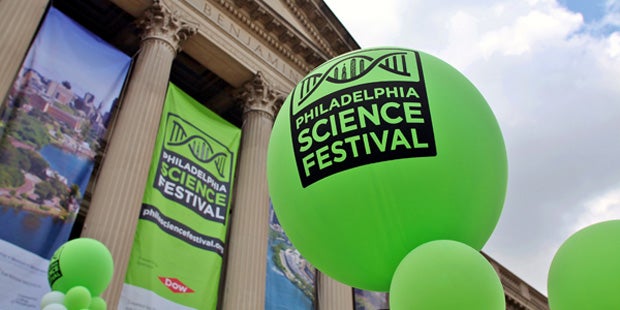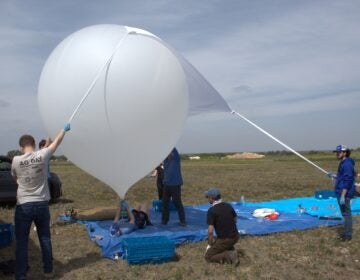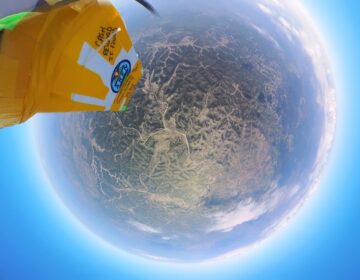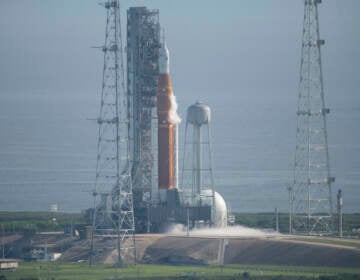Come to the Carnival!
ListenApril 15, 2013
[Dave Heller] Come one, come all: techies, geeks, freaks, families and those just looking for a fun time. The Ben Franklin Parkway is ground zero for Saturday’s Philadelphia Science Festival Carnival. Let’s learn more with barker and chief astronomer at the Franklin Institute, Derrick Pitts.
[Derrick Pitts] Yes ladies and gentlemen, step right up, step right this way – you’re in for a fun time all week long. So yes, the Philadelphia Science Festival is returning; it starts this Thursday and we have our very biggest event for the public on Saturday the 20th when out on the Ben Franklin Parkway from Logan’s Circle, right up the center of the parkway, all the way up to 22nd Street, we’ll have 105 different events going on at the same time representing science of all kinds on a really beautiful day. We’ll have outdoor solar observing, we’ll have four stages (some with music), [and] just about every activity you can possibly imagine related to science of various kinds.
But the Science Carnival is just one piece of this large event that runs from April 18 – 28th, so it’s really ten or eleven days of wonderful science at places all over the city, so it’s not just at the Franklin Institute. What happens is the Franklin Institute is coordinating this citywide event that involves all of the science entities of the city, and it’s everybody that you can imagine – it’s the hospitals, it’s the universities, it’s every entity you can think of that has to do with science. [The Franklin Institute] is happy to be involved in this for a couple of reasons; they get an opportunity to help the general public who they are and what they’re doing and what contributions they’re making, and they also help to pull together this network-neighborhood of people in Philadelphia who all do science because they love science! And we want other people to understand how fabulous science is.
-

Credit: Philadelphia Science Festival
So that’s a big key of it, the education part; the fun part to entice attendees to get interested as well.
Absolutely, because what we know is that everybody, to some degree, has some interest in science. But many people are afraid of science for one reason or another, and in this effort, we’re doing our best to help people understand that we can blow by all of those things that may have kept you from being involved in science – you’re afraid of it, the math is too hard, you didn’t take it in school – none of that matters at all. Because this whole program is to help you understand that there’s great content that you can access and have fun easily almost anywhere around the city and in any way you could think of it. Let’s say you like jazz, for example. There’s a program called The Science of Jazz. If you like beer, I can’t think of how many beer programs there are that are related to the science of beer, or other sciences connected through that. The same is true for food, there are many of those. There’s chemistry, there’s taxidermy, there’s a great program called Murder at the Mutter Museum. I think that’s a really cool one.
-

Credit: Philadelphia Science Festival
And one of the major events, one of the signature events, on Friday, April 26 is the Philadelphia Science Festival citywide Astronomy Night, where we will have telescopes at 22 different locations around the region, manned by amateur astronomers from astronomy clubs all around, sponsored by Celestron. It is a wonderful event for people to come out and look through good telescopes at what’s available in the night sky – but right in your own neighborhood! You don’t have to go downtown, or go to the mountains or go to the shore, you can do it right where you live and you’ll see the universe from where you live.
And on that night, will you be hunting for an asteroid candidate that we can lasso?
Boy, would that be a great thing to do. Actually, it’s NASA that’s going to be doing the asteroid lassoing, but not for a little while yet. NASA’s latest plan just put forth in its proposed budget for 2014 includes one hundred million dollars to begin working on this plan to send a robotic craft out from Earth to grab hold of a 25-foot wide asteroid, bring it back, and park it in lunar orbit. At lunar orbit what will happen is NASA’s manned-launch vehicle, the Orion Crew vehicle that they’re working on developing right now, will take four astronauts up to the asteroid at lunar orbit where they can explore it. They’ll work on it with raw cameras, they’ll dissect it, they’ll analyze samples and bring samples back to Earth while this object is in lunar orbit.
Do we yet have the technology to do this, or is this an idea first that could be implemented as time marches on, much like the race to the moon?
It’s actually an interesting amalgam of already existing technologies, technologies that are currently under development for different kinds of programs that are already on the boards, and new technologies that would have to be created to make this happen. One of the cool things out of this is that this funding can put towards developing our capability to identify large asteroids and small asteroids that may pose a threat to Earth. Because what we have to do to in order to accomplish this particular asteroid-capture mission is identify the right asteroid. So as a result of what happened back in February – the asteroid that exploded over central Russia – is there’s been a been call on us to get a good inventory of what’s out there where it’s headed. So that program has already begun, but this will add to that and make it more feasible for us to come to a conclusion about that much quicker. So, we could actually grab hold of a piece of clean, undisturbed material and look at the early history of the solar system right here in near-Earth orbit.
-

In this artist’s concept, an astronaut performs a tethering maneuver at an asteroid. The Space Exploration Vehicle (SEV) is close by, with the Orion Multi-Purpose Crew Vehicle (MPCV) docked to a habitat in the background. Image credit: NASA
Let’s look at technology already in place – there’s a launch site in a neighboring state of ours.
Here’s something that I think is a real sleeper: most people have never heard of the Mid-Atlantic Regional Space Port. Any idea where that is?
Are you talking about Bader Airport in Atlantic City?
A little bit further south than that – it’s actually what we have known as the Wallops Island Launch Facility that NASA has operated for decades. It’s been used as a location for the launching of atmospheric sounding rockets. Occasionally we have seen atmospheric tests in the sky of greenish-bluish clouds, or maybe some reddish clouds at night, and these are the results of these atmospheric tests being done with very small rockets from Wallops Island. But now Wallops Island is developing into a full-fledged launch facility. And in fact, Wednesday of this week, Wallops Island is planning to launch Orbital Sciences’ new launch vehicle called Antares. It’s 133 feet tall, 680,000 pounds of thrust in the first stages will lift 5,000 kilos up to a fairly low Earth orbit, about roughly 150 – 180 miles. The first time a launch vehicle of this size has been launched from that location. And here’s the real cool thing about it: Not only are there eight other launches planned from this facility going forward, satisfying a contract that Orbital Sciences has with NASA (totalling about 1.9 billion dollars in resupply capability to International Space Station), but the launch facility is open to the public to see. So rather than trucking down to Florida, right here in this region you can go to Wallops Island not more than a few hours away, and go see an actual rocket launch.
-
Rocket launch from Wallops Island
WHYY is your source for fact-based, in-depth journalism and information. As a nonprofit organization, we rely on financial support from readers like you. Please give today.




